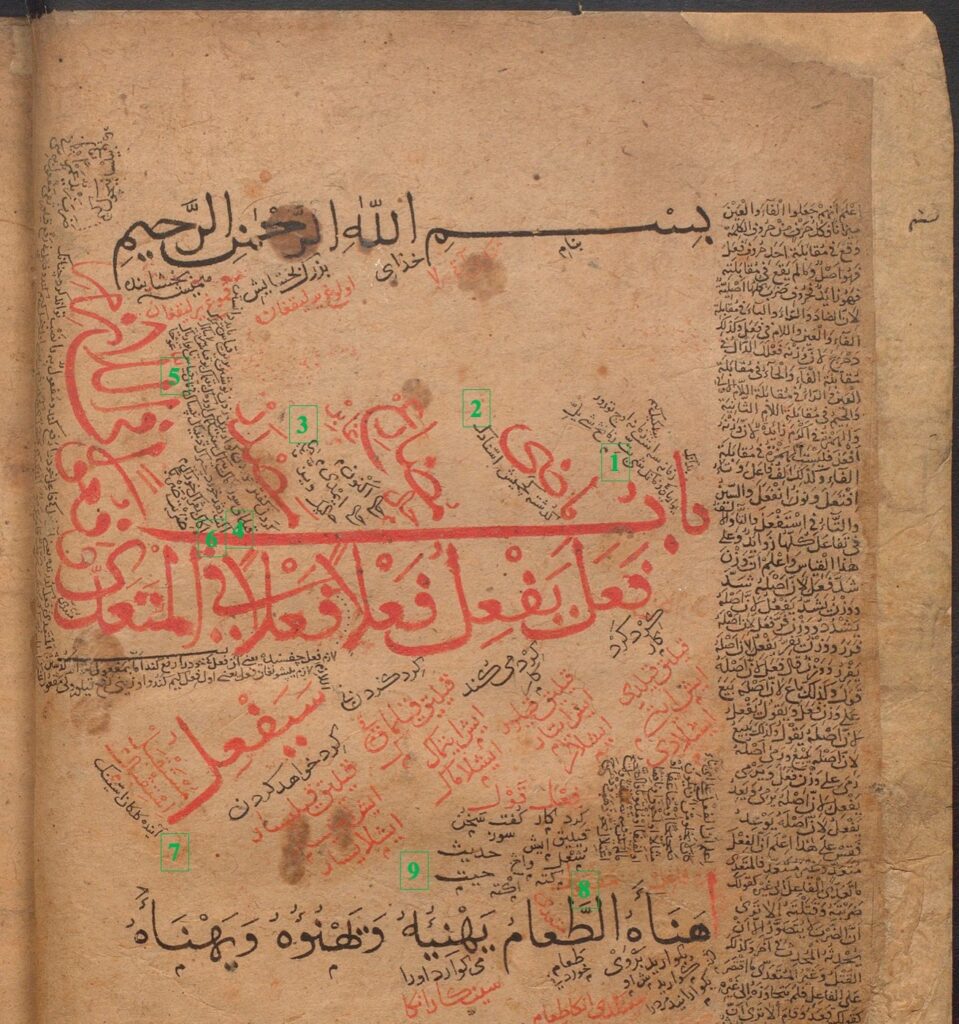Finding the Chorasmian glosses in Arabic manuscripts is not easy work. One has to closely examine numerous copies of the same work in order to find out whether some Chorasmian marginalia or short notes are present on a few folios, or not at all. While Yusuf Aǧa 5010, the main source of lexical material, has rather clearly-written glosses throughout, other copies of the Muqaddimat al-Adab have only a few, marginal Chorasmian words. Given just how many copies of that text exist, one doesn’t envy the scholars of previous generations who took it upon themselves to sift through thousands of folios in order to see if a given copy had any Chorasmian or not.
With British Library Add. MS 7429, a partial copy of the Muqaddima, David N. MacKenzie got rather lucky. There are Chorasmian glosses on the very first page, and only on that page, though tucked under and beside the more copious Persian glosses. One does wonder how far MacKenzie searched through the ms. before deciding there was no more Chorasmian to be found. Perhaps in a nod to that medieval scribe who wrote the Chorasmian, MacKenzie helpfully tucked his own announcement of the discovery of the glosses in this ms. and his edition thereof into a page in the middle of one of his reviews of Benzing’s Sprachmaterial (MacKenzie 1971: 524-525 “The Khwarezmian Glossary IV”). It was thus a while till I myself noticed this additional manuscript. A colophon for the section on particles (ḥurūf) dates Add. MS 7429 to Dhu ’l-Qa‘da 760 AH, or Oct. of 1359 CE—a date contemporary with the production of several other Chorasmian manuscripts.
Given that the glosses are so few, and the manuscript has been shared publicly by the BL, it will furnish a nice illustration of how Chorasmian glosses to the Muqaddima actually look. This particular ms. is glossed throughout in Persian and also has a few pages with glosses in what was then called “Eastern Turkish”, that is, Khwarezmian Turkic or early Chagatay.

Here are the glosses, quadrilingual or trilingual in most of the cases (based on MacKenzie’s interpretation with my comments). The glosses are reproduced exactly as in the manuscript and not normalized to standard spellings.
1. “know that languages are three”
Persian بدانك زفانه سى است
Turkic بيلكيل كم زفانه اوچ تورور
Chorasmian يواريان كي زفانك شي يتِّ زفانڅ شي يلِّ yw’ry’n ky zf’nk šy ytti zf’nc šy ylli
—The Chorasmian actually gives two variants, one with the singular zf’nk “language” with sg. copula yitti, and one with the plural zf’nc “languages” and pl. copula yilli.
2. “past”
Arabic ماضي
Persian كُدشته
Turkic كَچميش
Chorasmian اسّنادك ’ssn’dk
—The form ’ssn’dk is the past participle of the verb ’sn– ‘to pass, pass away’
3. “imperfect (of verbs)”
Arabic مضارع
Persian حالي اَكْنون
Turkic حالي ايمْدي
Chorasmian حاليك ويذَّ ويذيَ ḥ’lyk wyδδa wyδya
— MacKenzie incorrectly renders these wyδ and wyδy, but there are clearly visible diacritics on each word.
4. Examples of verbal nouns (Arabic مصدر) “to do, to speak, to eat, to digest, to hit, to write”
Persian كردَن كفتن خوردن كواريدن زدن نوشتن
Turkic قيلماق سوزلاماك ييماك سينكماك اورماك بتيماك
Chorasmian اكت بڤد خورد خىراك ذنبياك نتستاك ’kt bβd xwrd čBR’k δnby’k npst’k
—The first form ’kt is a verbal noun (m.) to ’k– ‘to do’. The other forms are present infinitives. The verb čBR– which should mean ‘digest’ in comparison, is incompletely pointed and not reconstructable from other sources.
5. “one should know them in this form”
Persian بر ين قياس بايد دانستن
Turkic بو قياس بىر بيلماك
Chorasmian في نان قياس نا يوارياك غوڅا fy n’n qy’s n’ yw’ry’k γwc’
—Lit. “In this form, thus it is necessary to know”. yw’ry’k is the pres.inf. of yw’ry– ‘to know’.
6. “eating, speaking, doing”
Chorasmian اكاك بڤراك خوراك ’k’k bβr’k xwr’k
—The Chorasmian forms are present infinitives (verbal nouns).
7. “future”
Arabic مستقبل
Persian آينده
Turkic كلكان
Chorasmian اسّنيك ’ssnyk
—The form is a pres.ptc. to ’s– ‘to come’. One would expect the writing ’ssnk and that ’ssnyk is the pausal form, but as no other word in this ms. is written with a pausal form, there is some uncertainty.
8. “deed, act, action”
Arabic فِعْل
Persian كرد كار
Turkic قيليق ايش شُغْل
Chorasmian واڅ كته اكته w’c kth ’kth
—w’c means “thing, matter”, while (’)kt is “deed, act”, in the latter case followed by the 3s. Chorasmian possesive suffix –h.
9. “speech, saying”
Arabic قَوْل
Persian كُفت سَخُن
Turkic سوز حديث
Chorasmian (?) حيت ḥyt
—The Chorasmian is uncertain, as not comparable with other words. MacKenzie assumed an error for حديث but that seems unnecessary given the consistent and careful spelling of all the other glossed words.
